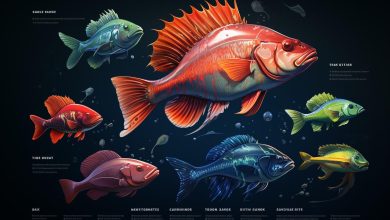DeepSea Fishing Techniques And Safety Precautions
Are you ready to venture into the deep blue sea and cast your fishing line for some big catches? Deep-sea fishing can be an exhilarating experience, but it also requires knowledge, skills, and precautions to ensure a safe and successful trip.
Imagine this scenario: You’ve planned a deep-sea fishing trip with your friends or family. You’re excited about catching some trophy fish, but you realize that you don’t have the right gear or techniques to handle the challenges of deep-sea fishing. This is where our guide comes in handy – we’ll provide you with essential information on equipment, techniques, safety measures, regulations, and more.
Deep-sea fishing refers to angling in ocean waters beyond 30 meters depth. The open sea offers a diverse range of game fish species such as marlin, tuna, swordfish, mahi-mahi, wahoo, and many others depending on the location and season. However, these fish are not easy to catch as they inhabit depths where conditions are harsher than those in shallower waters. That’s why it’s crucial to equip yourself with specialized tools and tactics for deep-sea fishing.
In this article, we’ll cover everything from rods and reels to bait selection and rigging methods. We’ll also discuss safety precautions such as weather monitoring, life-saving equipment like personal flotation devices (PFDs), first aid kits, communication devices like VHF radios or satellite phones in case of emergencies.
So let’s dive into the world of deep-sea fishing!
Essential Equipment and Gear
You’ll want to make sure you’ve got all the must-have gear and equipment for a successful trip out on the water.
When it comes to deep-sea fishing, rod selection is key. You’ll need a sturdy, 6-8 foot rod capable of handling heavy bait and strong fish. A spinning reel with at least 40-pound test line is also a must-have.
As far as bait options go, fresh or live bait tends to work best. Squid and anchovies are popular choices, but if those aren’t available, frozen bait can be used as well.
It’s important to have a variety of sizes and types of lures on hand too – this will give you more options when it comes to targeting different species of fish.
With your equipment ready, let’s move on to some fishing techniques that will help you bring in that big catch!
Fishing Techniques
The key to a successful catch lies in mastering the art of baiting and reeling in with finesse. When it comes to deep-sea fishing, selecting the right bait is crucial. Depending on the species you’re targeting, different baits will work better than others. Some popular choices include squid, octopus, shrimp, and sardines.
It’s important to research ahead of time what types of fish are common in the area you’ll be fishing in and what they typically feed on. Another technique that can improve your chances of catching a fish is trolling. This involves dragging lures or baits through the water while slowly moving forward with your boat. The idea is to mimic a swimming prey and entice a predator fish into striking.
Trolling works best when there are large schools of fish below the surface or when targeting faster-moving predatory species like tuna or marlin. By using these techniques along with proper gear and equipment, you’ll increase your likelihood of landing a big catch on your next deep-sea fishing trip.
Now that you have some tips for improving your catch rate, let’s move on to discussing safety precautions while out at sea.
Safety Precautions
Before setting out on your next adventure, it’s important to be aware of potential risks and ways to ensure a safe and enjoyable trip. Deep-sea fishing can be a thrilling experience, but it also comes with some inherent dangers. As you head out into the vast open ocean, make sure you have an emergency plan in place.
This includes having adequate safety equipment on board such as life jackets, flares, and a first aid kit. It’s also important to know how to use this equipment in case of an emergency.
One major factor that can impact the safety of your deep-sea fishing trip is weather conditions. Before heading out onto the water, check weather reports for any signs of storms or rough seas. If there are warnings about high winds or heavy rain, consider rescheduling your trip for another day. Even if the weather seems calm when you set out, conditions can change quickly at sea so always be prepared for the unexpected.
With these precautions in mind, you’ll be able to enjoy your deep-sea fishing adventure while staying safe and prepared for anything that may come your way.
As we move into discussing catch and release techniques, remember that safety should always come first when handling fish in order to protect both yourself and the fish themselves.
Catch and Release Techniques
When it comes to catch and release techniques in deep-sea fishing, there are a few key points to keep in mind.
First and foremost, proper handling and release is crucial to the survival of the fish.
Secondly, conservation efforts play a huge role in ensuring that fish populations remain healthy for future generations.
Finally, responsible fishing practices are essential in minimizing harm to the environment and other marine life.
By following these guidelines, you can enjoy the thrill of deep-sea fishing while also doing your part to protect our oceans.
Proper Handling and Release
Proper handling and releasing your catch is crucial for the health of the fish and ensures a sustainable future for all anglers.
To begin, it’s important to handle the fish gently and avoid touching their gills or eyes. Wetting your hands before handling the fish will help protect their slime layer, which is essential for their survival.
If possible, use pliers or a hook remover to safely remove the hook from the fish’s mouth without causing any further damage. Once you have successfully removed the hook, it’s time to release the fish back into its habitat.
Hold onto its tail and support its body with your other hand as you gently move it back and forth in water until it regains its strength and swims away on its own.
These best practices not only show ethical considerations towards marine life but also contribute to conservation efforts in keeping our oceans healthy for years to come.
Conservation Efforts
Conservation efforts are the lifeblood of sustainable fishing, ensuring that future generations can cast their lines and reel in a bountiful catch. One of the most effective ways to conserve fish populations is by establishing marine reserves, which limit or prohibit fishing activities in designated areas. These reserves allow fish populations to thrive and replenish, ultimately benefiting fishermen by providing more abundant catches outside of reserve boundaries.
Sustainable fishing practices also play a crucial role in conservation efforts. This involves using gear and techniques that minimize harm to non-target species and their habitats, practicing catch-and-release whenever possible, and adhering to regulations regarding size limits and closed seasons. By taking these steps, fishermen can help ensure the long-term health and productivity of our ocean ecosystems.
As you continue your deep-sea fishing adventure, keep in mind the importance of conservation and how your actions can contribute to sustaining healthy fisheries for years to come. Now let’s delve into responsible fishing practices.
Responsible Fishing Practices
It’s essential to practice responsible fishing if we want to preserve our oceans for future generations. Sustainable fishing is a crucial component of this effort. This means using ethical angling techniques that minimize damage to the marine environment and its inhabitants.
For example, instead of using large nets or traps that can catch unintended species, try using hooks and lines that allow you to target specific fish.
In addition, it’s important to make sure you’re following local regulations and laws related to fishing. This includes knowing the size limits for different types of fish, as well as any restrictions on when or where you can fish. By being aware of these rules and guidelines, you can help ensure that your fishing practices are not only sustainable but also legal.
With these principles in mind, we can do our part to protect the ocean ecosystem while still enjoying the thrill of deep-sea fishing.
Local Regulations and Laws
If you plan on deep-sea fishing, it’s important to be knowledgeable about local regulations and laws. In order to fish legally, you’ll need to obtain a fishing license.
Keep in mind that there may be restrictions and limits on what species can be caught and kept, as well as specific areas where fishing is prohibited due to protected species.
Fishing Licenses
You’ll need to make sure you have the proper licenses before heading out on your next fishing trip. There are different types of licenses available depending on where you plan to fish and what type of fish you intend to catch.
Some states require a general fishing license, while others may require additional permits for specific species such as salmon or tuna. Obtaining licenses is usually an easy process that can be done online or at a local government office. Fees vary depending on the state and the type of license needed.
It’s important to note that fishing without a valid license can result in hefty fines and even criminal charges, so it’s always better to be safe than sorry. Once you have obtained all necessary licenses, it’s time to move onto learning about protected species and how to properly handle them during your trip.
Protected Species
Learn how to identify and handle protected species during your fishing trip to ensure the safety and preservation of these important marine animals. Endangered species protection is a crucial aspect of ethical fishing practices, and it’s essential for every angler to be aware of which species are protected in their area.
Some examples of protected species include sea turtles, certain types of sharks, whales, and dolphins. It’s important to note that the regulations regarding protected species may differ depending on the location, so do your research before embarking on your fishing adventure.
If you accidentally catch a protected species while fishing, it’s important to release it back into the water as quickly and safely as possible. Avoid touching or handling the animal if possible, as this can cause undue stress or harm. Additionally, make sure you have the proper equipment on hand to quickly release any fish that are caught unintentionally.
Remember that these animals play an important role in maintaining a healthy ocean ecosystem, so always prioritize their safety when fishing.
Now that you know how to identify and handle protected species during your deep-sea fishing trip, let’s discuss some important information about fishing restrictions and limits to ensure you’re following all necessary regulations for a successful and responsible outing.
Fishing Restrictions and Limits
Now that you’re aware of the protected species in deep-sea fishing, it’s important to also understand the fishing restrictions and limits that are in place. These regulations aim to prevent overfishing and ensure sustainable practices for future generations.
One of the main restrictions is the designation of marine protected areas (MPAs), which limit or prohibit fishing activities in specific locations. It’s crucial to respect these boundaries as they help conserve important habitats and species.
Additionally, there are catch limits for certain fish species to prevent them from becoming depleted. Make sure to check with local authorities or fishing charters before heading out on a trip to ensure you’re following all regulations.
To practice sustainable fishing, it’s important to also consider using barbless hooks and releasing any non-targeted or undersized fish back into the water carefully. Remember that our actions have an impact on the environment around us, and being mindful of our practices can make a big difference in preserving our oceans for years to come.
Conclusion
Congratulations on learning about deep-sea fishing techniques and safety precautions! With the right equipment and gear, you can enjoy a fun and successful trip out on the open ocean. However, it’s important to always prioritize safety first.
Remember to familiarize yourself with catch and release techniques to help preserve marine life for future generations. Be sure to also research local regulations and laws before setting sail. By doing so, you’ll not only avoid legal trouble but also help maintain a healthy ecosystem.
But let’s be real here – there’s nothing quite like the rush of excitement when that big catch finally takes your bait. It’s an adrenaline-filled experience that will leave you feeling exhilarated for days. So go ahead, indulge in this thrilling activity – just make sure you do it responsibly!
After all, there’s no other feeling quite like reeling in a huge fish from miles below the surface of the water. It’s truly a moment that will stay with you forever.



